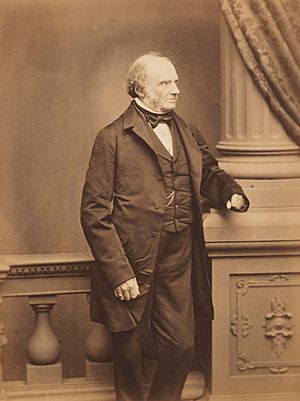London Conference of 1864 facts for kids
The London Conference of 1864 was an important meeting held in London. It was a peace conference aimed at ending the Second Schleswig War. This meeting took place from April 25 to June 25, 1864.
Lord John Russell, representing the United Kingdom, suggested that the war should be discussed at a European conference. This idea was supported by other powerful nations like the Russian Empire, France, and Sweden. However, the talks were heavily influenced by the recent victory of Prussia and Austria in the Battle of Dybbøl. This gave Otto von Bismarck and his team a strong advantage. The conference ended on June 25, 1864, without reaching any final agreement.
Contents
Why the Conference Happened
The government of Denmark wanted to make Schleswig a full part of their country. They tried to do this by creating a new constitution, known as the November Constitution. This constitution would join Schleswig with Denmark and separate it from Holstein.
On November 18, 1863, Christian IX of Denmark signed this constitution. But on December 28, Austria and Prussia made a proposal to the German Confederation. They wanted the Confederation to take control of Schleswig. This was meant to ensure Denmark followed earlier agreements from the London Protocol of 1852.
Denmark strongly rejected this idea. So, Austria and Prussia announced they would act as independent European powers. Lord John Russell first suggested a conference to keep things as they were before the war. But on March 11, the German powers signed an agreement. They declared that the 1852 agreements were no longer valid.
What Happened at the Conference
The British had plans for a ceasefire to be presented on April 12. However, Bismarck managed to delay the start of the conference until April 25. During this delay, German and Austrian troops won a major victory at the Battle of Dybbøl.
Difficult Discussions
The conference discussions showed how complicated the issues were. The Germans agreed to participate only if the 1852 London Protocol was not the main basis for talks. They also wanted the duchies (Schleswig and Holstein) to be connected to Denmark only through the king, not as a full part of Denmark.
The Germans also demanded that Denmark stop blocking German ports. A blockade means stopping ships from entering or leaving ports. The Danish team refused this. They said that cutting off sea transport was vital for their war strategy.
On May 12, 1864, the conference led to a ceasefire. But this truce soon broke down. The different groups could not agree on clear borders. Dividing the duchy of Schleswig seemed like a possible solution. On March 28, Lord Russell supported a plan to separate the German parts of Schleswig from Denmark. Napoleon III of France, who believed in the idea of self-determination (people deciding their own future), asked for a referendum. A referendum is when people vote directly on an issue.
Prussia's Goals
Count Friedrich Ferdinand von Beust, representing the German Confederation, wanted the Duke of Augustenburg to be recognized as the ruler of the duchies. Austria was leaning towards a settlement based on the 1852 agreements.
However, it became clear that Prussia wanted to take control of the duchies. Their first step was to make sure the duchies were completely independent. Austria couldn't really argue against this. Then, Prussia and Austria agreed that the duchies should be fully independent, but still connected by some shared rules.
Prussia's next move was unclear. They wanted to keep the option of taking over the duchies open. They also made it clear that any agreement must mean Schleswig-Holstein's military would be under Prussia's control. This worried Austria. Austria didn't want Prussia to become even more powerful. So, Austria started to support the Duke of Augustenburg's claims.
Bismarck had expected this. He offered to support the Duke's claims at the conference. But only if the Duke agreed to several conditions. These included putting all naval and military matters under Prussia's control. The Duke would also have to give Kiel to Prussia for a war-harbor. Prussia would also control the planned Kiel Canal and the duchies would join Prussia's Customs Union (a group of states that trade freely with each other).
The Danish Foreign Minister, George Quaade, said his country was ready for peace. But he had no answer from Copenhagen about the partition plan. Bismarck, on behalf of Prussia, agreed to divide Schleswig. However, he wanted Denmark to keep only a small part.
On June 25, the London conference ended without any agreement. The day before, Austria and Prussia made a new agreement. They declared that the goal of the war was now to completely separate the duchies from Denmark. After a short campaign that followed, a peace treaty was signed on August 1. The King of Denmark gave up all his rights to the duchies to the Emperor of Austria and the King of Prussia.



